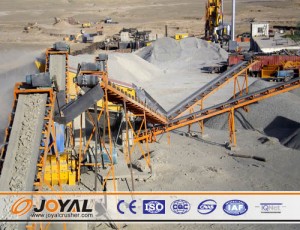

 Crushed stone or angular rock is a form of construction aggregate, typically produced by mining a suitable rock deposit and breaking the removed rock down to the desired size using crushers. It is distinct from gravel which is produced by natural processes of weathering and erosion, and typically has a more rounded shape.
Crushed stone or angular rock is a form of construction aggregate, typically produced by mining a suitable rock deposit and breaking the removed rock down to the desired size using crushers. It is distinct from gravel which is produced by natural processes of weathering and erosion, and typically has a more rounded shape.
Angular crushed stone is the key material for macadam road construction which depends on the interlocking of the individual stones’ angular faces for its strength. Crushed natural stone is also used similarly without a binder for riprap, railroad track ballast, and filter stone. It may also be used with a binder in a composite material such as concrete, tarmac, or asphalt concrete.
Crushed stone is one of the most accessible natural resources, and is a major basic raw material used by construction, agriculture, and other industries. Despite the low value of its basic products, the crushed stone industry is a major contributor to and an indicator of the economic well-being of a nation. The demand for crushed stone is determined mostly by the level of construction activity, and, therefore, the demand for construction materials.
Stone resources of the world are very large. High-purity limestone and dolomite suitable for specialty uses are limited in many geographic areas. Crushed stone substitutes for roadbuilding include sand and gravel, and slag. Substitutes for crushed stone used as construction aggregates include sand and gravel, iron and steel slag, sintered or expanded clay or shale, and perlite or vermiculite.
Crushed stone is a high-volume, low-value commodity. The industry is highly competitive and is characterized by many operations serving local or regional markets. Production costs are determined mainly by the cost of labor, equipment, energy, and water, in addition to the costs of compliance with environmental and safety regulations. These costs vary depending on geographic location, the nature of the deposit, and the number and type of products produced. Despite having one of the lowest average by weight values of all mineral commodities. Increased productivity achieved through increased use of automation and more efficient equipment was mainly responsible for maintaining the prices at this level.
Transportation is a major factor in the delivered price of crushed stone. The cost of moving crushed stone from the plant to the market often equals or exceeds the sale price of the product at the plant. Because of the high cost of transportation and the large quantities of bulk material that have to be shipped, crushed stone is usually marketed locally. The high cost of transportation is responsible for the wide dispersion of quarries, usually located near highly populated areas. However, increasing land values combined with local environmental concerns are moving crushed stone quarries farther from the end-use locations, increasing the price of delivered material. Economies of scale, which might be realized if fewer, larger operations served larger marketing areas, would probably not offset the increased transportation costs.